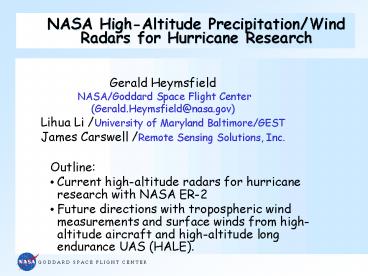NASA High-Altitude Precipitation/Wind Radars for Hurricane Research
1 / 17
Title:
NASA High-Altitude Precipitation/Wind Radars for Hurricane Research
Description:
First flown 1995, developed early 1990's. 4. G O D D A R D S P A C E F L I G H T C E N T E R ... incidence angle, conical scanner flown in hurricanes the past ... –
Number of Views:20
Avg rating:3.0/5.0
Title: NASA High-Altitude Precipitation/Wind Radars for Hurricane Research
1
NASA High-Altitude Precipitation/Wind Radars for
Hurricane Research
Gerald Heymsfield NASA/Goddard Space Flight
Center (Gerald.Heymsfield_at_nasa.gov) Lihua Li
/University of Maryland Baltimore/GEST James
Carswell /Remote Sensing Solutions, Inc.
- Outline
- Current high-altitude radars for hurricane
research with NASA ER-2 - Future directions with tropospheric wind
measurements and surface winds from high-altitude
aircraft and high-altitude long endurance UAS
(HALE).
2
Science Drivers
- Targeted observations and real-time information
from hurricanes other extreme weather events in
remote regions. - Tropospheric wind measurements with higher
spatial and temporal resolution than currently
available from lower altitude aircraft - HALE such as Global Hawk currently provide
long-duration (gt24 hours), high-altitude (gt18 km)
capability. - More than a decade of high-altitude Doppler wind
measurements from ER-2 aircraft over weather
systems including tropical storms
3
Current Hurricane Research Using ER-2 Doppler
Radar (EDOP)X-band (9.6 GHz)
- Nadir pointing beam -gt derive vertical motions
- Fixed forward pointing beam (30 degrees) for
derivation of along-track winds and
cross-polarization measurements. - First flown 1995, developed early 1990s.
4
Cloud Radar System (CRS)W-Band (94 GHz)
5
Radar Wind Measurements Motivating Factors for
Conical Scan
- Radar Wind Sensor (RAWS) (Moore et al., 1992)
- Spaceborne radar wind measurement study (X- and
Ka-band) with 30o, 35oconical scan funded by NASA
to complement Lidar Wind Sounder (LAWS)
Imaging Wind and Rain Airborne Profiler (IWRAP)
(Esteban, Carswell..2005) P3-based C- and
Ku-band, four incidence angle, conical scanner
flown in hurricanes the past seveal years
6
NASA Conical Scan Radars in Development
- High-Altitude Imaging Wind and Rain Profiler
(HIWRAP) - Ku, Ka-Band (14 and 35 GHz) radar funded by NASA
Instrument Incubator Program (IIP) Aircraft
WB-57, Global Hawk - Completion of basic system 15 months
- UAV Radar (URAD)
- X-Band (9.3, 9.4 GHz) funded IRD Goddard Space
Flight Center - Aircraft ER-2?, Global Hawk
- Completion of basic system 6 months
7
NASA High-Altitude Aircraft and HUAS
Global Hawk
WB-57
ER-2
WB57
Not Yet Operational
Altitude (kft) 70
631 60 to 65 Maximum Duration
(hrs) 8 51
30 Maximum Payload (lbs)
2,900 6,000
2,000-3,000 Max. Microwave Aperture (ft) 2
2.5 4.2
4.3
1Improvements in progress TBD 2Conical scan
requires large opening
8
URAD Measurement Concept
- Initial development 2004 Atlantic Seedlings and
Hurricane Experiment (ASHE) proposal using Global
Hawk to study TS cyclogenesis off the coast of
Africa - Nadir capabilities of EDOP, plus a second conical
scanning beam to provide estimates of horizontal
winds in cloud and the ocean surface winds. - Conical scan provides 3-D surveillance of
precipitation, horizontal winds in precip. and
surface winds. - Low cost solution using existing radar
technologies.
X-Band, separate nadir (9.4 GHz) and scanning
radar (9.3 GHz) subsystems, fully scanable
antenna up to 35 degree elevation.
9
URAD Configuration in Global Hawk
URAD was designed for installation with minimal
GH modifications
Interface for Global Hawk
Two-axis positioner to achieve conical scan and
elevation adjustment.
Scanning and fixed nadir antenna
10
URAD Hardware
Nadir Magnetron Subsystem
TWT transmitter, high voltage powersupply and
modulator
Two axis positioner to achieve elevation and
azimuth scan
Scanning Receiver hardware
11
HIWRAP Development
- Technology development emphasis.
- Utilize low power solid-state transmitter instead
of high power tube-based transmitter - more
suitable for high-altitude and space - Develop single aperture antenna for two beams and
two frequencies. - Develop high altitude, power efficient real-time
digital receiver and processor - GPM frequencies
3D winds (grid point retrieval) and
reflectivity Two frequencies and two incidence
angles to increase the number independent wind
measurements
12
HIWRAP Measurement Concept
Two look angles and two frequencies
Many independent radial wind measurements within
grid volume are used to calculate wind vector
13
HIWRAP Measurement /Accuracy Requirements
Based on 10 W Ka-band and 30 W Ku-band power
amplifiers
14
HIWRAP in Global Hawk
Scanner, slip ring fiber optical rotary joint
Aircraft floor
Power amplifiers RF front end
Mounting frame
Radar RF/IF
Antenna feeds
Antenna reflector
Radome
HIWRAP was designed for installation in GH with
minimal modifications
15
WB-57 Test Flights Planned Summer 2008
WB-57 6-foot pallet
Radome for Ku- and Ka-band
16
Summary
- Radar-based winds using conical scan from above
hurricanes and other extreme weather events is
promising approach for high-altitude aircraft,
HALE, and space. - HIWRAP hardware completion and flight testing on
WB-57 aircraft -gt Summer 2008. - Completion of basic URAD system by Fall 2007
- Migrate both radars to Global Hawk when one
becomes available. - Lidar-based wind instrument (TWiLiTE) due for
completion for WB-57 about same time as
HIWRAP---gt opportunity to remotely measure winds
in precipitation-filled and clear regions.
17
Tropospheric Wind Lidar Technology Experiment
(TWiLiTE) Instrument Incubator Program
- TWiLiTE will demonstrate, for the first time,
downward looking wind profiles from 18 km to the
surface obtained with an airborne direct
detection scanning Doppler lidar - Serves as a system level demonstration and as a
technology testbed - Leverages technology investments from multiple
sources - TWiLiTE is a collaboration of government
(NASA/NOAA), university and industry partners
Rotating telescope
Doppler Receiver
UV Laser
TWiLiTE system integrated on WB57 3 foot pallet
Source Bruce Gentry, NASA/GSFC































